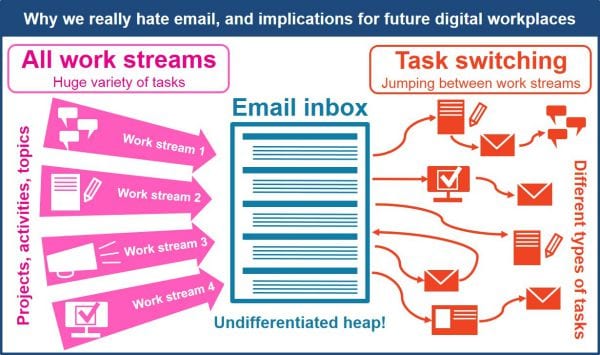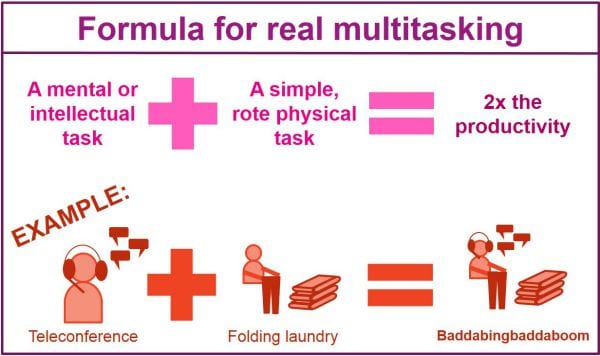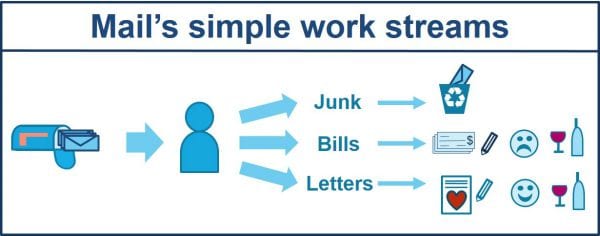Why we really hate email, and implications for future digital workplaces

Email forces us into constant task switching and is inefficient by design. But these particular weaknesses shine a light on the future of digital working and where vendors and experts can lead us.
Ugh. We all hate email… am I wrong?! The scourge of the modern workplace.
Experts create extensive systems to help people deal with email. Some organizations or individual “social collaboration evangelists” go on crusades to stop using email. Many intranet and digital workplace projects set key performance indicators (KPIs) of reducing email by some percentage.
And yet, we’re still using email all day long, every day. We’re still drowning in it. For some organizations, email is the only app that’s readily available on mobile devices. Embarrassing as it is to confess to, email is a cornerstone of the modern digital workplace and we don’t see the end of email in the immediate future.
But I do see a ray of light breaking through the grey clouds. Software vendors are doing some creative things with email and new platforms are integrating email into collaborative work streams. I think we’re actually on the verge of a big shift.
Before the industry goes too far, it’s worth taking a look at why we all really struggle with email so much.
Email is an undifferentiated heap of work streams and tasks
Each of us in our daily work have a variety of projects and ongoing activities we’re working on. These fall into what I’ll refer to as “work streams”. Each person’s work streams are different and each day we need to re-prioritize them a bit.
For any particular work stream there could be a wide range of tasks we need to accomplish, using different types of skills related to our specific jobs and using different applications.
Any one work stream could include all of these elements:
- Logistical discussions
- Strategic discussions
- Conversations with colleagues
- Conversations with clients, partners or vendors
- Meetings, calls and related scheduling
- Collaborative writing and editing
- Creation of content and media
- Storage of content and media (file folders)
- Project management and coordination
- Financial management
- Administrative tasks.
The problem is that email creates a non-differentiated dump of all our work streams and their plethora of different tasks. All of the above elements go through our email, for all of our work streams, with no prioritization.
It’s much more efficient for us humans to work on one work stream/topic at a time, or one type of task at a time. But email shoves it all together. That’s how email was designed, and that’s the model it forces upon us.
Conversation out of context
In addition to this dumping ground for… everything, email removes conversations from their varied contexts and forces them through just one channel.
If I need comments on a strategy paper I’m writing, it’s most helpful to have those comments linked to the content itself. Comments in Word docs are an example. Comments on a Google Doc are a better, more dynamic example.
But if those comments come only through email, then they are disembodied from the content they refer to and exist separate from the context.
By requiring us to jump back and forth between messages in email and our many other apps, we lose efficiency. This isn’t just the fault of email; all of our apps need to allow contextual collaboration and conversation. Many do in some form or another, but it’s rarely a smooth experience.
Imagine you’re in an office: If you need to talk to a group of people about a project, you book a conference room and a time, and go meet with those people to talk. If you have a question for a colleague, you saunter, or perhaps meander, down to her desk. If you’re in the cafeteria you run into people and have spontaneous conversations about life and work and maybe create important serendipitous connections. In an office you can engage in conversations in lots of different locations and contexts.
Now, imagine applying the email concept to your office: You’d have only one room where you could talk to people. Whether you want to talk to one person or a group, you’d always have to ask them come into that one particular room to talk.
If you’re in a meeting in the “talking room” and need to discuss a file, you will need to keep running out of the room to your desk to look at the file and then running back into the room to make a comment about it.
Pretty absurd, I know, but that’s the way email has designed our digital communication for us.
Email is task switching – inefficiency by design
The result of this dump of undifferentiated work streams and tasks, and conversation out of context from the work it relates to, is that email is task switching. Email is designed inefficiency.

Five consecutive emails in my inbox could be about five different projects, require the use of 10 different software applications, and require me to complete tasks using highly varied faculties.
Research has shown that the “transaction cost” of jumping from one thing to the next, and then back to the first thing, reduces our efficiency. Interruptions are costly.
Shifting from one type of work to another in quick succession requires a lot of mental energy. Hopping from one topic to another to another uses a lot of brainpower. The effort to make many rapid decisions (such as to prioritize emails and their related tasks) saps our brain’s processing reserves.
Research shows that our decision-making abilities decline during the course of the day. The more decisions we have to make, the further we reduce our capacity to make good decisions. And the stream of email we receive requires analysing, sorting, prioritizing and acting upon.
Email makes us inefficient.
Task switching, not multitasking
Some people think of email as multitasking, or labour under the false impression that they can email (look, it’s a verb!) while doing other tasks.
The reality is that there is only one real type of multitasking: doing one intellectual activity while doing one simple, physical rote activity. The human brain simply isn’t designed to complete two intensive thought processes at once.

So, responding to email while you’re on a conference call? Not multitasking.
Taking a conference call while you fold laundry? Yes, multitasking.
Responding to email while you drive? Not multitasking and you should have both your phone and car taken away.
Responding to email while you walk slowly at your treadmill desk? Yes, multitasking (awkwardly).
And just working on email is not multitasking, even when you’re dealing with lots of different types of work. You’re hopping from one task to the next, to the next, and the sequence of tasks could be very jarring. In fact, it often is.
The original mail: snail mail/paper mail
Back when mail (snail mail, paper mail, the post, etc.) was a thing, we had a pretty simple job before us: sort new mail between: 1) junk; 2) bills; and 3) correspondence. We’d throw out the junk mail, put the bills into a pile to pay reluctantly at the end of the week, and fondly write back to acquaintances while watching Friends on a Thursday night.

In the business context, actual mail got sorted in the mail room before it would get to specific people or departments. Product orders would go to the warehouse; resumes to HR; utility bills to the Facilities department; etc.
The original mail was very simple. But email is not.
Collaboration platforms, communities and channels
Collaboration platforms are already addressing this problem somewhat by being structured around groups, communities and channels.
Modern digital collaboration platforms tend to be sorted first and foremost by team or project, and the conversations take place within each group space. This design approach automatically sorts messages into their relevant work streams. Conversations have to be tied to a specific work stream, for the most part.
But email simply doesn’t do this. We can set up email folders and manually sort our new email into relevant folders several times a day (which is what I do), but that’s a hack rather than a design.
The reality is that email forces inefficiency on us, which is why it drives us so damn crazy.
But I’m not just here to rant. I think the shortfalls of email can tell us a lot about how to design digital working for the future.
The future: Work streams first, not apps or mediums
I predict that the future of digital working will offer tools that let us tie communications, content, tasks, applications, collaborative work and other elements together around work streams.
Imagine turning on your computer screen in the morning and seeing a list of your work streams, with all fresh content and conversations aligned to each one.
Imagine clicking on a “work stream” in your digital space and seeing a list of team members involved, upcoming tasks, recent conversations, recent content, related applications, etc.
Imagine a work stream that ties together all the related applications and content into one digital workspace that gives you a holistic view of a project or activity and easy access to the related tools and content.
That’s what I imagine, and I like it!
And we’re already seeing a move in that direction.
Leading tools like Slack, Collage by harmon.ie, Delve from Microsoft, and others create contextual experiences of digital work that integrate apps, content, communication and collaboration.
Or, conversely, there are products that bring content and apps from other tools into the email interface, like harmon.ie Email, Xobni and others. But these tools are just the start.
Our work is defined by the tools we have available. In the digital workplace, the tools are far behind what we need and how we could work. Email has forced inefficiency upon us by applying the previous paradigm’s structures. It’s time to envision a future of work designed around true digital productivity. And I think we’re ready.
Categorised in: Collaboration, Content management, Digital workplace, Intranet usability
